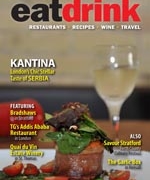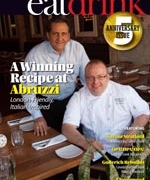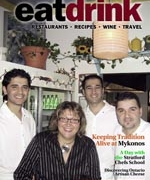A Harvest of Canadian Food Writing
With the autumn harvest of regional foods behind us and the fresh sprouting of spring gardens still months away, it’s time to embark on a harvest of a different sort – the culling of good Canadian food writing to sustain a restless mind through the winter months. Or, if you find yourself in the throes of Christmas preparations, this list could help alleviate the gift-buying anxiety for any of those patriotic foodies in your life.Canada is a country known for its vastness and it stands to reason that its culinary traditions across all that geography are quite regional. Truly locavore foods have become emblems of Canadian pride: lobsters on the east coast and salmon on the west, wheat fields in the bread basket prairies of the world, fiddleheads in the Maritime forests, potatoes on Prince Edward Island, split pea soup in Quebec, peaches in the Niagara Peninsula, and corn in south western Ontario. With even so much more in between, including stretching back through time with historically-significant foods of The First Nations, like pemmican (jerky-like buffalo meat with dried berries). The history of our country has stories through food and there is an array of Canadian authors capturing these stories in print.
Dorothy Duncan has written several books that mix the historical with the culinary. By trade, Duncan is a museum curator, historian, and cookbook researcher living in Orillia, and her writing takes us back to mealtimes of yore. Nothing More Comforting and Canadians at Table are two books comprised of short tidbits of food-related and historical topics, such as The Beaver Club dinner, founded in 1785 and still held today, paying tribute to the explorers and fur-traders of days gone by who hunted our nation’s most symbolic animal (and yes, cooked beaver tails have been a dish served at these dinners in the past). Political picnics held by John A. MacDonald during election campaigns in the mid-1800’s were one way to get votes, appealing to the constituents stomachs. Chuck wagon cooks deserve a special place in Canadian folklore as they filled the plates of hungry, Albertan cowboys. She is also a proud Ontarian, with her essay reminding us that the McIntosh apple was founded in the late 18th Century by John McIntosh in current day South Dundas Township.
Also by Duncan, Feasting and Fasting, is an interesting book highlighting the holidays that people in the True North, strong and free, have celebrated throughout history: from the potlatch and powwow ceremonies of the First Nations to modern-day parties of the immigrant Irish (and those who wish they were Irish) on St. Patrick’s Day. With Canada’s melting pot reputation, Duncan writes how festivals and feasts came to be diverse as well: “Newcomers from around the world arrived in colonial Canada with a multitude of beliefs, superstitions, traditions, and observances. These customs didn’t all focus on one date, but the celebration has evolved into a blending of the rituals of many people and many lands. Sometimes newcomers have been influenced by their new neighbours and friends and have integrated new customs into their own depending on the community where they settled.”
Duncan is quite aware that her historical renditions are relevant to the present state of food. There is nothing industrialized or manufactured in her books, it is all wholesome, from-the-earth food reminiscent of the current focus on local eating. Duncan’s books offer a plethora of recipes to accompany the historical facts about the foods she discusses and many of them come from historical books, some dating back to the 1700’s, that have stood the test of time. She encourages us to keep the old, sometimes ancient, standbys alongside modern recipe books. History has proven to have sound techniques, even amidst modern technology, since cheese makers have been using the same techniques for thousands of years. Although not an official holiday, the First Nations people treated the “sugar moon” arriving after the equinox to be a sign to start sap tapping maple trees and a time to be thankful and to feast on foods flavoured with the first syrup of the season. Sugar shacks across Quebec continue to hold pancake breakfasts to celebrate their syrupy product.
For something still with a strong historical slant, but having more of a quirky, sociological aspect to it, try delving into Margaret Visser, an iconic Canadian cultural writer since the 1980’s, who has made a career out of what she calls “the anthropology of everyday life.” Mealtimes are a large and recurring part of our daily routines and her two books centring on food, Much Depends on Dinner and The Rituals of Dinner, offer an entertaining look at the cultural aspects of meals. “Food shapes us and expresses us even more definitively than our furniture or houses or utensils do,” she writes in Much Depends on Dinner and goes on to describe nine separate and representative foods, not only how they fit into a meal, but how they have a notable history of their own. For instance, how Kellogg’s corn flakes were derived from corn kernels by the Kellogg brothers in the early 1900’s and have been as sacred to breakfast as corn cobs were to the original Indian cultivators thousands of years before. Her later book, The Rituals of Dinner, explores how table manners govern our human interactions at mealtimes.
The traditions of a country originate with its first inhabitants. In Canada, The First Nations lived off the land, in harmony with the seasons, eating only what was in their near vicinity. Even though most Canadian regions have harsh winters, the seasons govern the food supply across our country, from maple syrup tapping in March, to the first signs of asparagus in the spring, to apple harvests in September. Eating with the seasons and keeping in touch with the cycles of nature is a great way to nourish ourselves, and our home and native land offers a variety of options throughout the seasons. The First Nations were essentially being locavores before the word even existed. (The word locavore itself originated in 2005, as CBC Radio’s food columnist, Sarah Elton, reveals in her book titled Locavore. It was declared word of the year in 2007 by the Oxford American Dictionary). Looking back in history, as Duncan does, it is easy to see that eating locally was a way of life, including using herbs and plants for medicinal purposes, with such oddball remedies as honey as a baldness prevention and beet juice to alleviate dandruff. The First Nations people and settlers who first consumed new foods on Canadian soil, would approve of the modern experiment by Alisa Smith and J.B. MacKinnon which they documented in another Canadian book, The 100-Mile Diet.
Using the word “diet” in the title tends to bring fad diets to mind, but it is far more than that: starting out as an experiment, then becoming a movement, and evolving into a very important lifestyle that reduces the importation of food. It would be wrong to clump it together with fad diets, but rather as an activist mission to bring awareness to the miles that food travel to get to our plates, and the repercussion those miles have on our planet and our bodies. The book is an interesting first-person account of a couple willing to take a leap of faith, written in tandem with MacKinnon as the gung-ho spear-header of the project and his girlfriend, Smith, a bit more pessimistic with fears of starving. Both voices interplay nicely for the story to unfold on both sides as they reveal their “self-inflicted exile from the industrial food system.”
I particularly like MacKinnon’s emphasis on how salads should be made based on the seasonal whims of what is available. “A spring salad is not a process, but a pattern. The choice of greens depends day by day on seasonal weather.” The greens available in their own community garden during the summer months were inspiration for salads to elevate themselves from the typical iceberg or romaine lettuce from the grocery store. Plant guides were important for keeping toxic vegetation out of their foraging baskets, a necessary resource for anyone doing the same in their own region. Aside from their own foraging, farmers’ markets delivered their mother lode of fresh, local foods and they shared the opinion that “A farmers’ market is an act of reconnection” where they “could relate each item not only to its place but to its specific farm and to the faces of those farmers;” in contrast to the anonymity of grocery store food.
The same idea makes sense for the food-producing business as a whole: “North American consumers will eat produce from distant places they will never visit, though they might easily have grown the vegetables in their own backyards. In fact, they might be eating that imported produce at exactly the same time that it’s growing just a few miles away. This is called ‘redundant trade;’ consider, for example, the fact that international strawberry imports to California peak during that state’s strawberry season.”
One question that comes to mind is how did they arrive at this 100-mile distance and what does it really mean? The number was chosen to shrink (at least for them personally) the food miles from farm to plate of common ingredients, which average 1,500 miles for a typical meal. This meant not eating many things they took for granted, but now must be excluded because the ingredients were not local – tea, salt, cooking oil, rice. They had escape clauses in their plan when traveling for work or eating meals as invited guests at the houses of others, but when they did divert from their 100-mile criteria with something as mundane as a TV dinner at Smith’s grandmother’s house, she says: “I felt undernourished. I was spoiled from eight months of good food, fresh-picked or home-canned. I craved 100-mile meals, no matter how many potatoes they might involve. That food made me feel alive.”
But the real question is “Can anybody do it, 100 miles from wherever they are?” As they discovered first hand in Mexico, many parts of the world eat this way naturally or out of necessity. Smith and MacKinnon, while certainly challenged by the limitations, were successful in Vancouver, but not everyone has the Fraser River – the most productive salmon river in the world – within 100 miles. And it is the seasons they relied on for their bounty, having to plan ahead for winter by canning corn and tomatoes in the autumn. They were also surrounded by the bounty of local products like gooseberry wine and chestnuts – high quality products they may never have discovered if not for their experiment. And that is the greatest lesson in the book – we all have these hidden gems close by if we take the time to look and enjoy local products.
Aside from their close-knit, 100-mile success in British Columbia, another Canadian author and contributor to The Toronto Star, Margaret Webb, has given us a menu of local delicacies that can be found from coast to coast across the country, in her book, Apples to Oysters: A Food Lover’s Tour of Canadian Farms. The book is arranged as a menu with a cross-country selection of appetizers to desserts from all ten provinces. The oyster and scallop appetizers are not just any seafood, as with all subjects in the book, they come from a specific fisher or farmer on a specific plot of sea or land, in this case Johnny Flynn’s oysters from Colville Bay in Prince Edward Island and the scallops from the farm of Duncan Bates in Nova Scotia’s Mahone Bay. You know Webb is seriously emphasizing the local aspect of her book when we learn about dulse from the Bay of Fundy – a type of seaweed that is not largely known outside the Atlantic Provinces, but in New Brunswick is considered a healthy and vibrant snack.
As scrumptious as the local delicacies are throughout her journey, food becomes more than just food. The people keeping us connected to our food are more important – the type of people that Webb describes as “obsessive nuts – chefs of the soil, tractor-seat philosophers, self-trained geologists and biologists, thingamajig implement inventors and food educators all hard-wired into an ever-ready labourer who often works from sun-up until sundown.” She is talking about people like Cecil Werner who turned flax seed into a health craze from his Saskatchewan farm and a dairy farmer in Quebec who knows each of his cows intimately to better prepare his cheese. Alberta farmers at Diamond Willow Range practice “holistic range management” of their cattle, knowing that not all beef is created equal and “a great steak starts in the field, long before it ever hits the kitchen.” And it is the chefs who buy supplies from farmers that farm with the same intensity and passion that they cook that bring the cycle to fruition, their menus identifying where ingredients in their dishes were grown.
Even in the unlikely climates of the Yukon Territories, the variety of potato known as Yukon Gold thrive as a great-tasting spud partially due to being grown so far north with extended hours of sunshine in the Land of the Midnight Sun. While picking potatoes in the Yukon, Webb wonders “when did we come to expect produce to look as if it sprang from a sparkling laboratory rather than from the ground?” Good food comes from the land, the same dirt we walk on, and to have all food squeaky clean in perfect packaging, takes away from its true heritage; that is one reason farmers’ markets are so popular – they support the image of where food comes from and support the people who provide it, “a new generation of Canadian farmers who are putting nutrition and taste back into the foods we eat.” Webb’s message is clear that even amid the disappearance of much farmland to the spread of urban sprawl, “we must look to our farmers not only as food producers but as cultural ambassadors, environmental stewards, our artists of the soil and sea.”
In Locavore, Sarah Elton investigates several entrepreneurial farmers who are countering urban sprawl with innovative ways of implementing urban agriculture, like gardens on mall rooftops to stock nearby restaurants. Elton labels these people, and many others who have been changing the industrialized food system as “local heroes” including Christie Young from Guelph, as only one example, who founded an apprenticeship program, called FarmStart, for those who want to succeed in the agriculture industry but don’t yet have the technical background. The program supports non-farmers who are attracted to the new ideals of farming, but need coaching on developing a successful business model.
The group of authors highlighted above are also local heroes spreading the word about the current food revolution. Books like these do not only culturally and historically enrich us, but arm us as smart consumers. As Elton writes in Locavore: “Every choice I made at the grocery store was suffused with larger issues and had implications not only for our family’s pocketbook and our health, but the future of the planet.” Because a local hero is not only the farmer who sells his eggs from his farm on the outskirts of your town or the artisan baker around the corner, but also every consumer who chooses to support them. We stand on guard for thee, locavore suppliers and consumers, and we ask God to keep our land as plentiful and varied as it has been throughout history.










